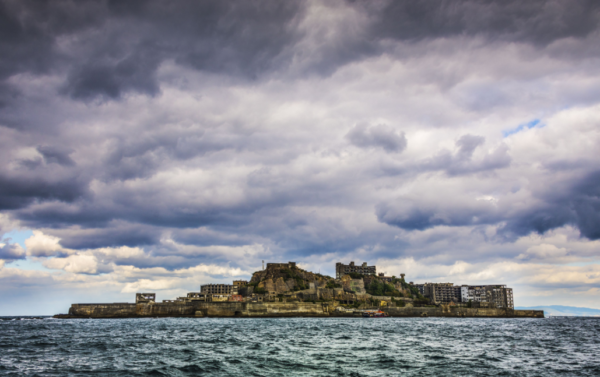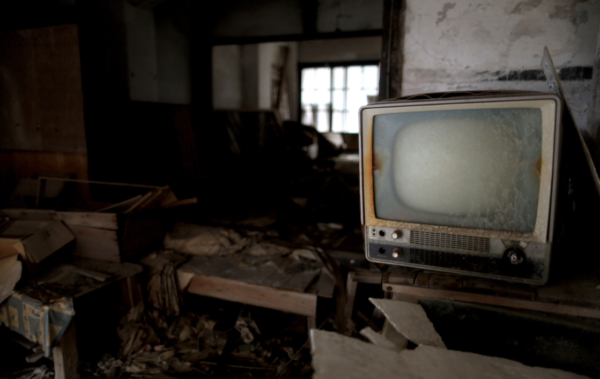15 miles off the South Coast of Japan, just a short boat ride from the city of Nagasaki, Battleship Island floats eerily and alone, surrounded by the ocean. Now left in ruins, this island holds the remains of Hashima, a man-made structure of just 16 acres that was built at the beginning of the Japanese Industrial Revolution in 1887.
Various aliases are associated with the island; the sea walls create a silhouette that is similar to a battleship, hence the name. It is also renowned for being constructed entirely of concrete buildings, and was therefore referred to by locals as “the island with no green”. However, due to the passing of the time, and the shocking events that happened in the time that Hashima was populated, it is now best known by another name: Ghost Island.

The Island of Hashima was once a thriving metropolis, housing employees of a coal mine (once owned by Mitsubishi) that was situated directly under the island structure. Citizens of Japan were extremely keen to live there at the beginning of the 20th Century: the concrete building were revolutionary, as not only did they protect people the people living there from the harsh conditions out at sea, but they also boasted a higher standard of living than the rest of the country. Even for today’s standards, the residents in Hashima were very well off. The island boasted a kindergarten, school, temple, town hall, post office and community centre. For leisure, they enjoyed a club house, cinema, swimming pool, rooftop gardens, shops, a pachinko parlour (a form of Japanese slot machine gambling), and even a brothel! At the end of the 1950’s, Hashima Island was one of the most densely populated areas on the planet, with more than 5000 inhabitants living in the 16 acres. To put this into context, that’s 50 times smaller than Central Park in New York.
Unfortunately, not everybody was so lucky on the Island. During the 1930’s and 1940’s, in the period surrounding World War II, forced labourers from Korea and China were sent to Hashima and ordered to work the coal mine. Unlike the Japanese citizens’ spacious apartments, the Korean workers were made to live in cramped and unhygienic areas; many slept in closets. Approximately 500-800 people were relocated to the island for forced labour, and due to the poor conditions, being poorly fed, and working shifts of up to 12 hours a day in the coal mine that was 200m below the surface of island, many tried to escape, and any trying. Local records declare that 123 of the Korean workers and 15 of the Chinese workers died due to the hardships that were inflicted on them in their time on the island. It is believed that many more died but went unrecorded.
In the early 1970’s, the mine’s life span was close to expiry, as coal was depleting. Additionally, petroleum was becoming the main source of energy in Japan. Due to this, in 1974, the mine shut. There was no longer a purpose for the workers on the island to live there, and jobs back on the mainland weren’t plentiful, so everyone had to rush back to Nagasaki to secure an income and a home for themselves and their families. Within the space of a week, nobody was left.
What remains is a creepy sight. Concrete blocks were left in ruins, but the hardy material means enough still stands to give you a true sense of what it must have been like to live on the island. 44 years later, relics of past lives are still scattered throughout the buildings: an intact mosaic remains on the wall of the school, and a slide once frequented by the children in the playground of the school now stands alone.
Amongst the abandoned apartment blocks, TV sets still sit in the corner of living rooms, unfinished bottles of sake are stacked on shelves, and washing up still left in kitchen sinks reminds us of how quickly people left the island. It is as if they were desperate to get away.

In 2009, after been untouched for 35 years, the island was reopened, and tourists are now able to take tours of a small section of the remains; it was even given UNESCO World Heritage recognition in 2015. Many locals and foreign neighbours alike are not keen on this – Korean nationals disputed this recognition, due to the horrors and human rights violations that occurred there, and voices from China, South and North Korea agreed. There are even those who believe that the island is haunted by the workers that unlawfully died in the depths of the mine.
However tragic, Hashima Island certainly possesses a unique and strange story. The coal mine below the surface once reaped the land of resources, but despite being known as the “island with no green”, Hashima is now taking back what it lost, and is beginning to be reclaimed by nature. Whether or not it is truly haunted, whilst the physical reminders of the island may completely disappear, the memories of the inhumane treatment of forced workers will forever remain on ‘Ghost Island’.







